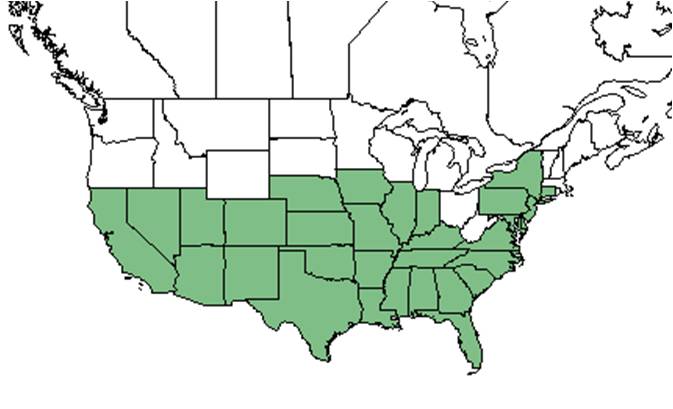Difference between revisions of "Heterotheca subaxillaris"
KatieMccoy (talk | contribs) (→References and notes) |
KatieMccoy (talk | contribs) (→Description) |
||
| Line 23: | Line 23: | ||
<!-- Basic life history facts such as annual/perrenial, monoecious/dioecious, root morphology, seed type, etc. --> | <!-- Basic life history facts such as annual/perrenial, monoecious/dioecious, root morphology, seed type, etc. --> | ||
A description of ''Heterotheca subaxillaris'' is provided in [http://www.efloras.org/florataxon.aspx?flora_id=1&taxon_id=242416651 The Flora of North America]. | A description of ''Heterotheca subaxillaris'' is provided in [http://www.efloras.org/florataxon.aspx?flora_id=1&taxon_id=242416651 The Flora of North America]. | ||
| + | |||
| + | ''Heterotheca subaxillaris'' is an annual in temperate climates and a short lived perennial in subtropical climates (Lonard et al. 2011). Leaves are simple and are alternately arranged, with one leaf per node. The leaves produce a camphor-like aroma which defers herbivores <ref name="uswildflower">[[https://uswildflowers.com/detail.php?SName=Heterotheca%20subaxillaris]]Accessed: December 15, 2015</ref>. The yellow composite flowers are arranged in diffuse, paniculate corymbs. It is a C3 plant in carbon fixation (Lonard et al. 2011). | ||
==Distribution== | ==Distribution== | ||
Revision as of 15:59, 17 December 2015
| Heterotheca subaxillaris | |
|---|---|

| |
| Scientific classification | |
| Kingdom: | Plantae |
| Division: | Magnoliophyta - Flowering plants |
| Class: | Magnoliopsida - Dicotyledons |
| Order: | Asterales |
| Family: | Asteraceae ⁄ Compositae |
| Genus: | Heterotheca |
| Species: | H. subaxillaris |
| Binomial name | |
| Heterotheca subaxillaris (Lam.) Britton & Rusby | |

| |
| Natural range of Heterotheca subaxillaris from USDA NRCS Plants Database. | |
Common name: camphorweed
Contents
Taxonomic notes
Description
A description of Heterotheca subaxillaris is provided in The Flora of North America.
Heterotheca subaxillaris is an annual in temperate climates and a short lived perennial in subtropical climates (Lonard et al. 2011). Leaves are simple and are alternately arranged, with one leaf per node. The leaves produce a camphor-like aroma which defers herbivores [1]. The yellow composite flowers are arranged in diffuse, paniculate corymbs. It is a C3 plant in carbon fixation (Lonard et al. 2011).
Distribution
Ecology
Habitat
In the Coastal Plain in Florida and Georgia, H. subaxillaris occurs in open sand with sea oats, pine-scrub oak sand ridges, longleaf pine-wiregrass savannas, and upper beaches. It has been found in disturbed areas such as railroad bridges, powerline corridors, vacant lots, along highways, wet roadside ditches, near phosphate ponds, fire lines, and cleared sand pine-evergreen oak scrub (FSU Herbarium). Soil types include loamy sand and sand (FSU Herbarium). Associated species include Andropogon, Baccharis, Setaria, Cenchrus, Distichlis, Paspalum urvillei, P. notatum, Eragrostis oxylepis, Eleusine indica, Digitaria sanguinalis, Cyperus surinamensis, Ambrosia artemisiifolia, Strophostyles helvola, Solanum americanum, S. sisymbrifolium, Daubentonia drummondii, and Sesbania exaltata (FSU Herbarium).
Phenology
Flowers March through November and fruits in September (FSU Herbarium).
Seed dispersal
Seed bank and germination
Fire ecology
Pollination
The following Hymenoptera families and species were observed visiting flowers of Heterotheca subaxillaris at Archbold Biological Station (Deyrup 2015):
Andrenidae: Andrena fulvipennis
Halictidae: Agapostemon splendens, Augochloropsis metallica, A. sumptuosa, Halictus poeyi, Lasioglossum nymphalis, L. tamiamensis
Megachilidae: Anthidium maculifrons, Coelioxys mexicana, Megachile albitarsis, M. brevis pseudobrevis, M. inimica, M. xylocopoides
Sphecidae: Bicyrtes capnoptera, Microbembex monodonta, Tachytes validus
Vespidae: Pachodynerus erynnis, Stenodynerus fundatiformis, Zethus spinipes
Use by animals
Diseases and parasites
Conservation and Management
Cultivation and restoration
Photo Gallery
References and notes
Deyrup, M.A. and N.D. 2015. Database of observations of Hymenoptera visitations to flowers of plants on Archbold Biological Station, Florida, USA.
Florida State University Robert K. Godfrey Herbarium database. URL: http://herbarium.bio.fsu.edu. Last accessed: October 2015. Collectors: Loran C. Anderson, Robert Blaisdell, A.F. Clewell, G. Crosby, M. Darst, Dawn Doran, Geriuld Wilhelm, Mark A. Garland, Robert K. Godfrey, Bruce Hansen, JoAnn Hansen, C. Jackson, R. Kral, Robert L. Lazor, Robert J. Lemaire, D.W. Mather, Travis MacClendon, Sidney McDaniel, Richard S. Mitchell, John B. Nelson, Gwynn W. Ramsey, R.L. Redfearn Jr., Cecil R. Slaughter, H. Larry Stripling, Bian Tan, D.B. Ward. States and Counties: Florida: Bay, Calhoun, Citrus, Clay, Columbia, Escambia, Franklin, Hernando, Indian River, Jackson, Leon, Levy, Madison, Marion, Okaloosa, Pinellas, Polk, Suwannee, St. Lucie, Wakulla. Georgia: Jasper. Compiled by Tall Timbers Research Station and Land Conservancy.